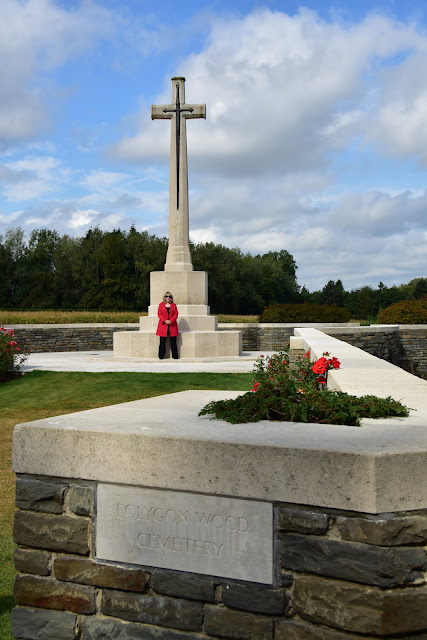It is quite impressive how the monuments and cemeteries are maintained and revered by the French. There is the new Pheasant Wood cemetery for the 200+ diggers that were found in recent times buried by the Germans after the battle in an unmarked mass grave. It is attached to a new interactive museum which documents not just the military history, but the personal experiences of the soldiers and civilians who experienced what must have felt like Armageddon.
We took a quiet, reflective drive through the flat rural fields to VC corner and the "Cobber" statue and couldn't help but wonder how any of the men survived such an experience unscathed, which of course none of them really did. Being ordered to charge across flat, boggy ground with wire, shells, nerve gas and machine guns chattering at you, with absolutely no cover gives one pause to stop and consider the contrast with the peaceful rural landscape now...which we did.
By about 3pm we were getting pretty tired as we hadn't really slept since Singapore so headed off towards Bruge. A little easier said than done as I'd forgotten what it was like driving on the right, in a manual, with strange street signs through tiny villages with windy, cobbled lanes and a Sat Nav which is an imbecile!
Needless to say we had a comprehensive look at much of the countryside in the North of Belgium on our "Tour" .....and there may have been a few "tense" moments along the way!
Bruges is really a very beautiful town. Old, quaint ( too much quaint really) and vibrant. Cafes, and shopping and restaurants and shopping and canals and shopping and architecture and shopping and history and ....well you get the picture. We had a wonderful time there and would recommend it as a "must see" to anyone visiting this part of the world......oh, and Belgian beer is really good!
We planned to see the Northern Battlefields on our way South from Bruges so took the opportunity to stop off at a fantastic museum at Passendale and so the Australian Cemetery at Polygon Wood. The way the French and Belgians have embraced the preservation of these war sites and the museums dedicated to ensuring understanding of the history of the war is really impressive. The museum was huge with lots of interactive exhibits including trenches and dugouts and smells of mustard gas and we came across an example of a "flying pig" which killed Walter Allen, listed as missing on the wall at Villers- Bretoneux.
The Polygon Wood cemetery was a "front line" cemetery so the graves were all scattered rather than in lines because they were burying soldiers under fire and, in our wanderings, we found a relative of Wendy's in the British Butte cemetery nearby overlooked by the impressive 5th Division monument.
Our drive to Bullecourt took an "unintended" scenic route which meant we were running late to our accommodation in Amiens. The museum there has a long history beginning with a local farmer digging up relics for many years and displaying them at his farm and, in fact, they still uncover 40 tonnes of metal and ordnance in the fields every year...even one hundred years later. Over time the Australian Government became involved and, to their credit funded what is a wonderful museum.
All this an much more out of a local farm and they are still finding bodies....one we saw was from 1998.
We arrived late into Amiens but found our digs (on the 5th floor with no lift!) and enjoyed a meal and a beer in one of the street cafes that specialises in "people watching". The Somme tour coming up.














No comments:
Post a Comment